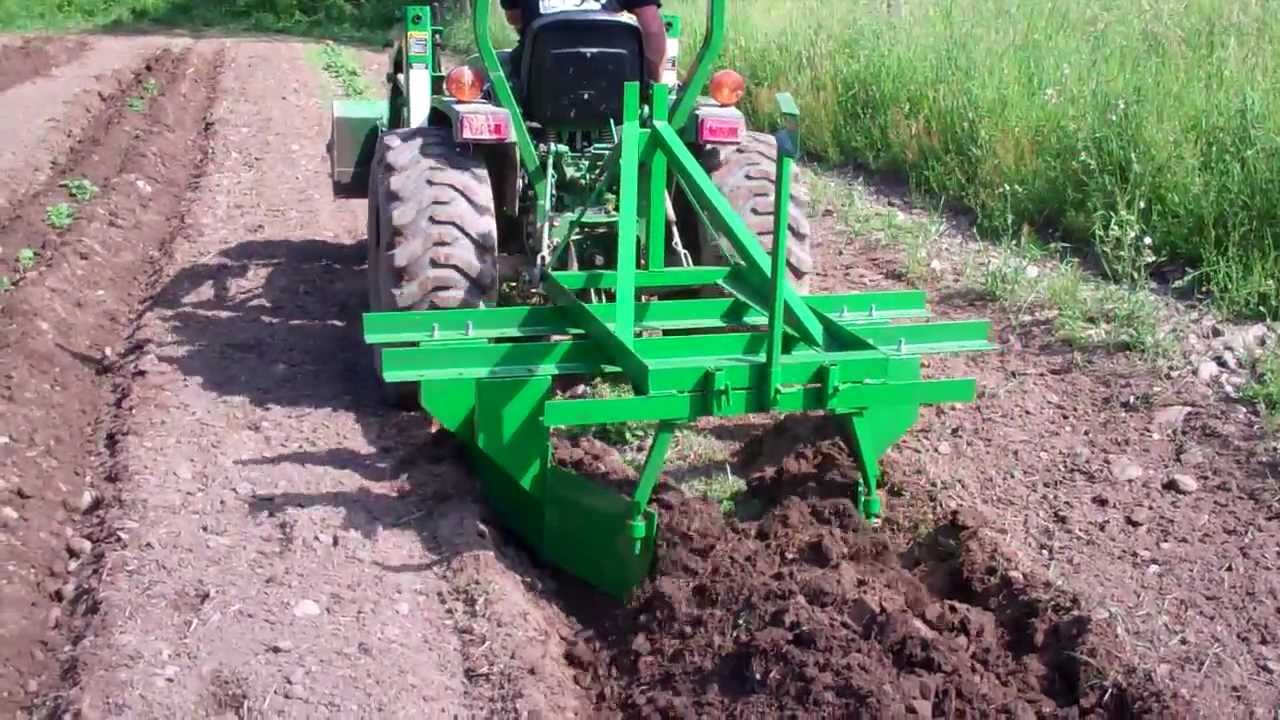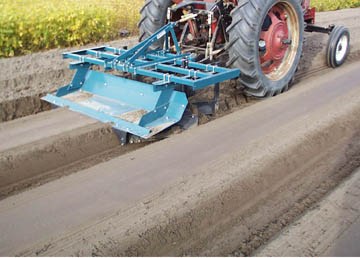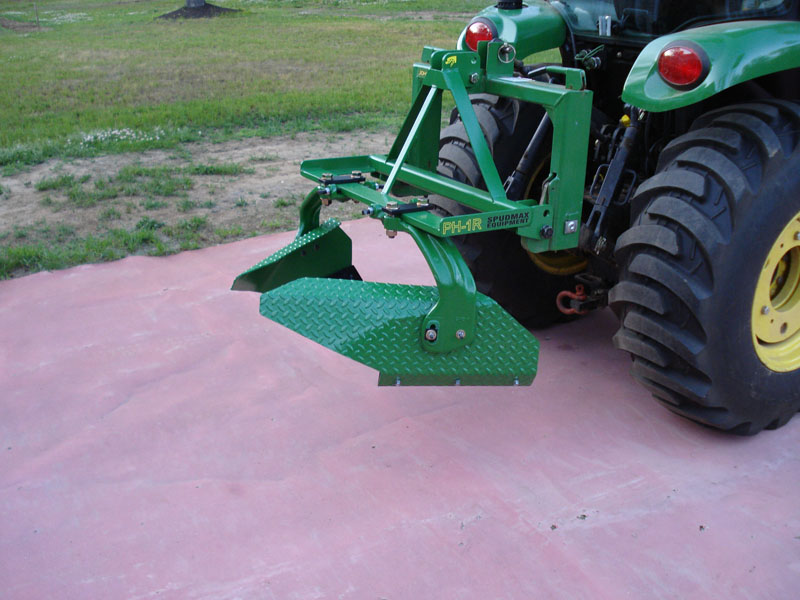Raised Bed Farming
Many small farms are converting from flat land field management to raised beds. There are several considerations to go through before converting to raised beds that we’ll cover here.
“Raised-beds are a type of planting crops in which furrows – long, narrow trenches made in the ground by a plow – are widely spaced and crops are planted on raised strips. The width of the strips is determined to ensure homogeneous adequate water distribution into the soil profile to meet crop water requirements.”
Why Consider Raised Bed Farming ?
One of the biggest reasons to consider raised bed agriculture is water management. In areas that receive excessive moisture at key points in the season raised beds may be a good fit. Since they are above the surface of the land, they can shed water more easily, and if done properly, the growing media where the plant’s roots are can avoid waterlogging, which can destroy a crop.
On the other hand, during dry periods, a raised bed will dry out quicker, and that can be bad for the crop as well. In many raised bed systems, provisions to irrigate are needed if extended periods of dry weather are common. They make for a good fit for trickle or drip irrigation, and in some locations, flood irrigation is used between the rows, allowing for water to diffuse through the soil to the roots of the crop being grown.
“Environmental benefits of raised bed farming include a reduction in soil salinity, soil and water pollution, water logging, and drainage water.”
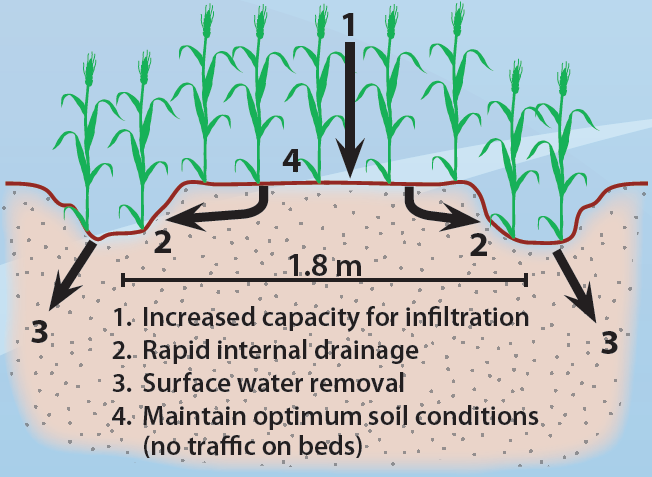
Cross-section diagram of a raised bed and the way it operates to drain, aerate and prevent waterlogging. Source: (https://www.soilquality.org.au – Raised-Beds)
Crops best suited for Raised Beds
Almost any crop can be produced using a raised bed system, but some are better suited than others. The other thing to consider relating to crops is their susceptibility to mud splash, leaf diseases, and root rot; as raised beds can help you keep these challenges at a minimum because you get better air exchange in the bed than if they’re planted flat with a lot of residue on the surface of the soil.
Root crops like carrot, potato, cassava, and others can do well in a properly managed raised bed. And if you are harvesting them mechanically, you will save a lot of time, effort, and money, the task will be done in a more efficient way (remember the potato digger of the past article?). The only thing to remember is that most likely the beds will be deteriorated in the process and will need to be reshaped before planting another crop into them.
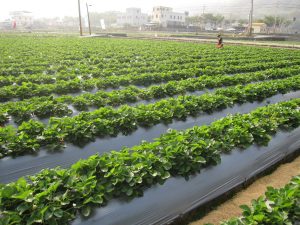
Strawberries on Raised Beds using Plastic Row Covers and Irrigation (source: https://noobfarmers.blogspot.com/p/blog-page.html – Raised Bed Plasticulture)
Greens like lettuce, spinach, and other leafy vegetables can also do well, but close attention needs to be spent on providing irrigation in dry times of the year, as these are shallow rooted crops that can die quickly without water in a drought period.
Fruiting Vegetables like peppers, tomatoes, and others can do very well in a raised bed system, especially when they might be subjected to heavy rains and high temperatures, as these conditions favor foliar diseases in these crops.
Grass crops like corn (maize), wheat, and other small grains are not as well suited to raised beds, though it’s not impossible to grow them using that method. Many small gardeners will grow corn on raised beds in areas where flooding would prevent their growth at all but typically, the root system of maize needs room for its brace roots to grow. Grasses are also very shallow rooted and are subject to drought more than many of the crops you’d grow alternatively.
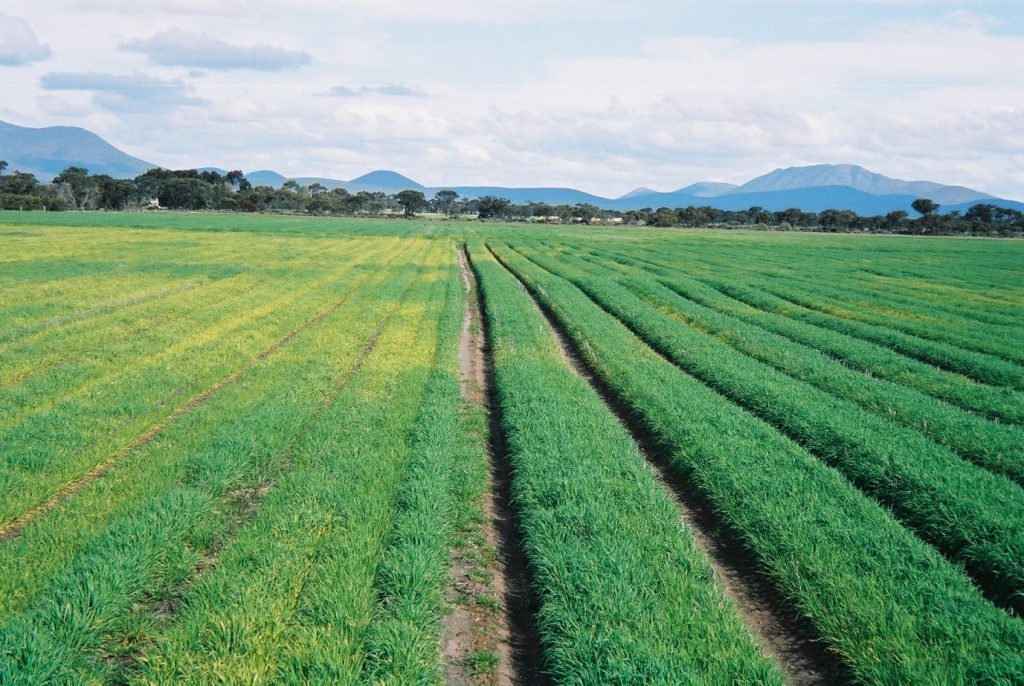
Small Grains on Raised Beds in Flood Plain of Western Australia (source: Cropping Practices for Raised Beds – Dept of Agric and Food – Western Australia
Forming the Raised Bed – there are two ways to form an earthen raised bed.
Rototill and Shape: In this method, you’d work the flat ground thoroughly into a fluffy blend. You’d want to incorporate the organic residues thoroughly into the soil. Rototillers and rotovators can accomplish this quite well. You then must ‘shape’ the bed with a bed shaper (pictured below). There are machines that combine these operations as well.
Moldboard Plow, Rototill, Shape: In this method, you would use a 1-2 bottom moldboard plough, flipping two passes inward into a ‘backfurrow’. You’d then rototill that raised ground, and shape it.
Key Considerations:
Some key considerations when establishing raised beds include:
- Is it to be a permanent raised bed? In this system, you are either growing perennial crops, or crops which can be harvested above ground leaving the bed in tact. Even in this system, you’ll want to go in and reshape the bed if it is damaged excessively.
- Make sure to make allowances for wheel width of your tractor so you can re-enter the field if necessary to spray, fertilize, cultivate, or harvest. Also consider traffic areas if hand work will be needed and workers need to walk between the rows.
- Direct your rows so as to allow for water to drain if flooding is a concern. A slight slope along the contour of the field is best to prevent excessive erosion.
Crop fertilizing
The raised-bed system greatly improves all-weather access on waterlogged sites. This improves the opportunity for growers to apply mid-season fertilizer. On raised beds, it is important to apply fertilizer precisely on the sown rows of crop on the beds, and to minimize fertilizer in the furrows.
Fertilizer that lands in furrows is unlikely to be used by the crop and is very likely to be transported off-site and become a nutrient pollutant to streams and rivers.
Swathing and harvesting
Harvesting crops on raised beds differs from harvesting on normal seedbeds only in terms of the constraints imposed by tracking the harvesting equipment in furrows. Ensure all mobile machinery has wheel tracks that fit the furrows, otherwise they need to operate on specially-constructed access tracks, cross-drains, or at the end of the field on the headland or catch drain. Swathing is possible with some adaptions.
Tractor Power
Needed tractor power primarily depends on bed height. For example, nearly any field tractor with a 3-point hitch can form a 4-inch high bed. A good practice is to use at least 35 HP for a 6-inch bed and at least 50 HP for an 8-inch bed.
Raised beds can be an effective method to raise vegetable and root crops in many situations with a little planning and knowing your soils and crops, you can increase yields of healthy crops. Allowances for irrigation if needed, proper drainage of the beds, plant spacing, use of row covers if necessary, and other considerations can often be brought together to create a very successful raised bed system for your farm.
You don’t need to take a huge loan from the bank to invest in a super-big tractor if your farm is medium to small size, with a good subcompact tractor or ATV and the right equipment you can do the job and be more productive, and perhaps having more harvest per year.
John Deibel, Freelance Writer for TractorExport
Read more:
No till and raised beds boost yields – New Agriculturalist
Raised Bed Farming in Western Australia
Raised Bed Cropping – Soil Quality – Australia
https://www.fao.org/neareast/news/view/fr/c/410067/


